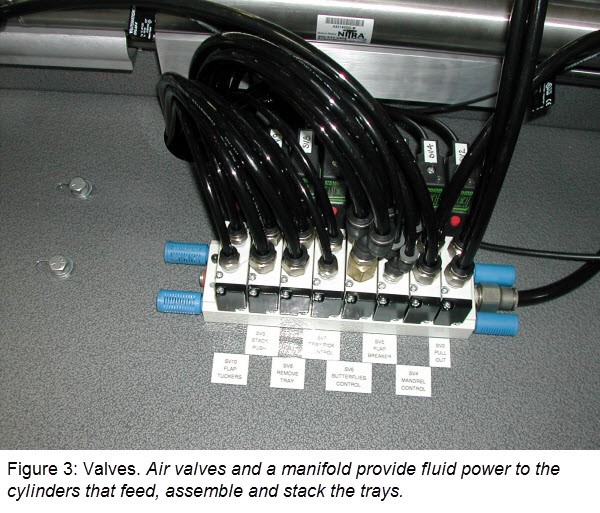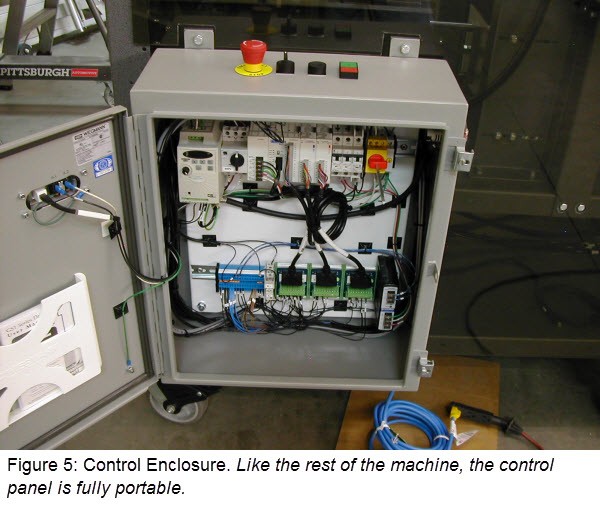Ridgeline Machine made extensive use of pneumatics when building a low-cost, small-footprint, portable traymaker to replace a manual process for one of their customers.
Ridgeline Machine Design, LLC (RMD), founded in 2012, is primarily a packaging machinery producer, and the company’s owners have over 40 years experience designing and building custom machinery. RMD builds packaging machinery for a variety of applications for product placement into AFM, FOL, HSC, RSC cases or trays, and they have also branched out into robotics and machinery for consumer cooler production.

Some of the packaging equipment they design and build includes wraparound side-, end- and bottom-loading case packers in many configurations. RMD also builds case erectors, bag-in-box equipment, case sealers and traymakers.
Engineered Equipment
RMD has hundreds of installations in several industries including baking, food, dairy, personal care, chemical and others. RMD designs packaging equipment for products such as coffee, construction adhesives, aerosol, spices, and cartoned and canned food. Their equipment handles products housed in configurations such as chipboard trays and cartons, corrugated trays, plastic bottles, gable-top cartons, fiberboard caulking tubes, semi-rigid bags, and steel or plastic cans and tubs.
Their packaging equipment typically handles from 10 to 50 cases per minute depending on the application, and they offer a case sealer capable of speeds of up to 114 cases per minute. RMD equipment typically has an open design for easy operation, quick maintenance and simple adjustment.
For example, one of their case erectors builds regular, slotted-case, all-flaps-meet boxes with hot melt closure, and it can be adjusted for a wide range of box sizes using just two hand wheels. Another example is a case packer used where case sealing with pressure-sensitive tape is needed. This flexible machine can be changed over in 15 minutes or less. Some case erectors are designed for many SKU changes and can change over in two minutes.
Their bottom-load case packer works well for applications where a traditional drop-case packer is a poor choice due to possible product breakage during the loading cycle. The machine’s design provides a gentle bottom-up feature which results in greatly reduced shock to the product as it’s placed into the case.
Leading motion technologies employed in their machines include pneumatic, servo pneumatic and pure servo, each controlled by various PLC platforms. RMD uses the latest 3D software from SolidWorks to design their equipment.
Putting Experience to Work
For one particular project, RMD started with a list of specifications from a manufacturer of custom door locksets and hardware based in the western U.S. RMD set out to meet these specs using pneumatics in a creative design. Pneumatics was selected as the motion control technology for this application due to its low cost, both up front and over time. It is simpler than alternatives such as electromechanical or servos, easy to understand and maintain, and straightforward to control and troubleshoot.
The Model 25 automatic traymaker was developed in partnership with their customer for this project; the machine assembles trays at a rate of 18 per minute with minimal floor space required and at an affordable price (Figure 1).

Traymaker specifications from the client included a small footprint, portability, low cost, easy operation and simple maintenance. The customer also required a finished tray table with 50-count storage.
Because the machine is portable, it operates from 120 VAC to simplify power connection, and to improve safety. Competing machines typically require 208-230/460 VAC, and are quite a bit more expensive. A small portable footprint is needed due to limited floor space and the need to move the traymaker often. Low cost was another requirement, and one of the reasons AutomationDirect hardware was chosen.
The customer needed to automate an operation which traditionally required their plant personnel to make the trays by hand. The production rate was only four trays per minute, and the new machine assembles trays at a rate of 18 per minute, a significant improvement. The automated machine also freed up four workers who are now performing other tasks to further improve the customer’s production processes.
The traymaker discharges each tray on its side to help the trays stack better (Figure 2), whereas most traymakers on the market discharge the tray upright. RMD’s older model traymaker had the tray blank move horizontally before set-up, while this new model has it traveling vertically. This required mechanical reorientation of much of the infeed assemblies.

Traymaker Ready for Production
The RMD Model 25 traymaker has a small footprint of approximately 7’H x 5’L x 3’W without the discharge table. The discharge table is 6’L x 4’W. The traymaker is controlled with a wide variety of AutomationDirect hardware including power distribution components, motors, drives, and safety relays and switches. AutomationDirect also provided an extensive pneumatic system starting from the main plant connection, proceeding to the flow controls, solenoids, tubing, fittings and cylinders.
Much of the product handling and assembly operations are pneumatic. The traymaker includes vacuum pick-off of tray blanks, vertically positioned to save space. The singulated tray blanks are fed into the system using an AC drive powering a motor and a worm gearbox which drives the tray blank feeding wheels.
The vertical, wheel-delivered tray blanks are fed downward to the assembly area, and are then set up by a pneumatic cylinder pressing the blank through tooling. The formed trays are then pneumatically offloaded to the discharge table.
Pneumatic Assembly of Trays
The traymaker pneumatic components start with a 3/8-inch size filter, regulator and lubricator feeding a bank of valves operating a mix of round, compact and tie rod cylinders. Air preparation provides the required high air flow, and also filters and lubricates the air coming to the machine. The air prep system includes an electric dump valve to relieve the air supplied to the control valves when a door is opened or an emergency stop is pressed. There is also a manual lockable valve on the inlet, providing the required lockout/tagout functionality when servicing the equipment.
Air valves (Figure 3) control all cylinder and vacuum generator operation. The valves are sized for worst case flow for any function on the traymaker. In this case, 4-way valves were specified to control all the cylinders, as their Cv rating of 0.89 is sufficient for the cylinders to operate and maintain proper speed. A 3-way valve was selected to operate the pneumatic vacuum generator for the same reason.

RMD prefers to use manifolds to feed air to the pneumatic control valves, and utilizes an 8-station unit on this machine for that purpose. To ensure a high flow air supply, ½” tubing is used to supply air to the valve manifolds. Plastic silencers on both ends of the manifold reduce noise and ensure minimal restriction of exhaust air.
The valves were wired using solenoid cables which include built-in surge suppression and an LED to show when power is present to the solenoid. Surge suppression improves the life of the PLC outputs by eliminating voltage spikes, and the LED indicator clearly shows valve status which simplifies and speeds maintenance.
Pneumatic Cylinder Details
The pneumatic cylinder configurations were specified based on space constraints and required motion. In places where the cylinder is producing rotational motion, either by moving a lever or pushing a rack turning a gear, the machine uses tie rod cylinders with built-in cushions. For other low power or supplemental motion, the machine uses either round-body (Figure 4) or compact cylinders.

Pneumatic cylinders provide all the motion required to feed, assemble and stack the trays (except for the vertical tray blank feed wheel motion, which is electromechanical). All cylinders critical to the assembly/setup of the tray include magnetoresistance sensors along with magnetic pistons in the cylinders. The sensors provide error-proofing of cylinder end-of-stroke motion for each step of the machine assembly sequence.
The Nitra® pneumatics from AutomationDirect work as well as their more expensive competition, and RMD has used them in lubricated and non-lubed applications with great success.
Supplier Selection
RMD chose AutomationDirect as a primary supplier of the traymaker automation, power, pneumatic and other components. They were selected for the affordability and quick availability of the wide variety of products required for this application. AutomationDirect’s technical documentation is available 24/7 on their website, and phone support is available without a support contract. Other factors leading to their supplier selection included the free customer support forum, free 2-day shipping and free programming software.
The traymaker is controlled by an AutomationDirect CLICK C0-00DR-D PLC with expansion I/O and terminal blocks for field wiring. A bulkhead programming port with outlet on the control enclosure door simplifies compliance with arc flash regulations as it allows changes to be made to the controller software without opening the door (Figure 5).

AutomationDirect also provided the power distribution hardware including a non-fused disconnect switch, branch circuit protection circuit breakers, and a rotary motor protector switch to disconnect power from the motor drive.
Operator control buttons include a selector switch, pushbuttons and an E-stop mushroom pushbutton. To sense the product, background suppression photoeyes and cylinder position sensors were used.
The end result shows that, with strong customer buy-in, you can build a reliable machine using the affordable products provided by AutomationDirect. Other factors valued by this and other customers include simple operation, low maintenance and industry-leading customer support.
Byline: Todd Dice, General Manager at Ridgeline Machine Design
Originally Posted: Jan. 28, 2016


